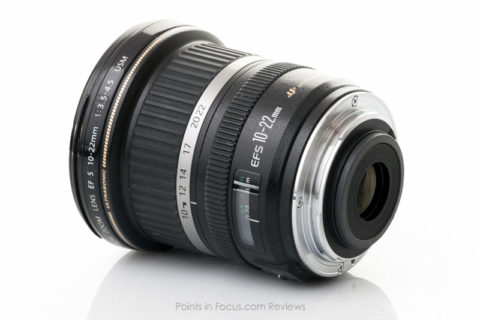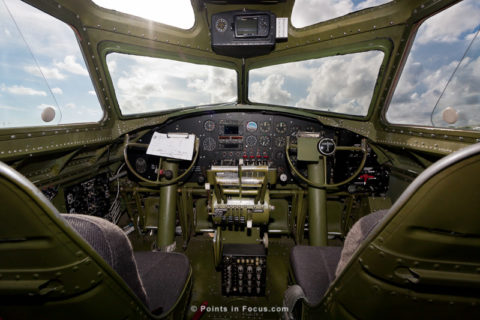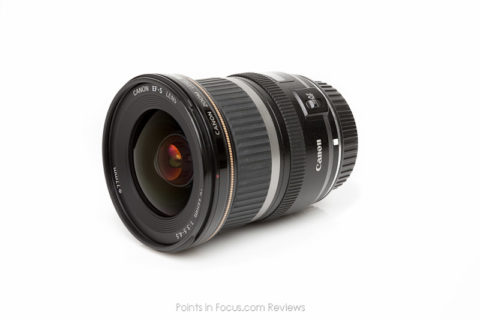Canon EF-S 10-22mm f/3.5-4.5 USM Lens Review
This was one of my favorite lenses, and still would be if I hadn’t replaced it with a EF 16-35mm f/2.8L II USM and a full frame camera. In fact, the only reason a considerably larger fraction of my image library wasn’t shot with my 10-22 is that suitable places to shoot stunning ultra-wide-angle images are few and far between around here.
Build
Canon has elected not to allow their EF-S lenses to given L status; as a result, there are no built-like-a-tank EF-S lenses. There are, however a hand full of nearly-built-like-a-tank EF-S lenses, and the EF-S 10-22mm f/3.5-4.5 USM is one of those lenses (the other two are the EF-S 17-55mm f/2.8 IS USM and the EF-S 15-85mm f/3.5-5.6 IS USM).
That said the build quality of camera lenses always seems to surprise me in some ways. I bought my 10-22 used, because the lens was expensive when I bought it and it’s even more expensive now. It turns out I’m the 3rd owner of the lens, and while it’s certainly been around, the lens is very good shape.
The outer lens barrel is tough, I’m not sure if it’s metal or plastic, but it seems to match the feel, strength, and sound of many of Canon’s L lenses. The finish is a hard, slightly textured, black coating. Like the material itself, the finish seems to match what Canon uses on most of their black L lenses, as well as some of their higher end non-L lenses. The hard finish holds up to ware and use very well.

The lens uses what I would call a quasi-internal zoom design. The outer lens barrel and thus overall length of the lens doesn’t change as the focal length is adjusted, instead the front element moves inside the lens barrel when the focal length is changed. The filter rings seal, or at least close, the entire area where the lens shifts. Though the lens isn’t weather sealed, given the design if I was shooting somewhere that had fine particulates or salt spray, I would definitely want a protective filter installed more than I otherwise might.
On the plus side, the 77mm filter threads don’t rotate when either focusing or zooming so you don’t have to worry about your split NDs going all wonky. You can use this lens with a circular polarizer, but due to the wideness of the angle of view, you’ll have problems with uneven polarization in skies.
Handling
The EF-S 10-22mm f/3.5-4.5 USM follows the standard layout for consumer zoom lenses. That is the zoom ring is large and placed towards the front of the lens barrel and the focus ring is small and placed near the camera. There are pros and cons to this arrangement, though in general use, I find I slightly prefer this setup to the pro arrangement where the focus ring is placed forward and the zoom ring near the camera. Especially when using these lenses with the EF to EF-M mount adapter on an EOS-M, where the forward positioning of the zoom ring makes it considerably easier to manipulate.
As for the zoom ring, the textured rubber grip is 3/4 of an inch wide, however, the entire front 1-1/2” of the lens, from between just forward of the gold USM braid, and just behind the focal length numbers, rotates when zooming. Thanks to the quasi-internal zoom design, the force needed to turn the zoom ring remains very consistent at all focal lengths regardless of the orientation of the lens. The total travel for the zoom ring is about 45° from one stop to the other.
Compared the zoom ring, the focus ring is a mediocre experience. Of course, on an ultra-wide-angle lens there’s not a lot of focusing that needs to be done.
In any event, the focus ring is narrow, only 3/8ths of an inch wide, and ribbed hard plastic. It’s a similar, if not identical, design as to the focus ring on the EF 28-135mm f/3.5-5.6 IS USM, EF-S 17-55mm f/2.8 IS USM, or EF-S 15-85mm f/3.5-5.6 IS USM. Turning the focus ring though it’s 90°, or so, throw is smooth, at least as smooth as this kind of focus ring gets. Because the lens uses a ring USM motor, there are no hard stops when the limits are reached; though like other ring –USM lenses, there is a slight but noticeable increase in resistance past the limits.
Though my lens is well used, the feel of the focus ring is not appreciably different from the one in my 28-135, which is quite reassuring in terms of how well you can expect the system to hold up over time.
Like most of Canon’s non-L lenses, Canon cheeps out and doesn’t pack a lens hood in the box. This is especially galling in light of the fact that it costs them probably $1 to make and they charge nearly $35 for the hood on top of the $850 for the lens. If you want a hood, do yourself a huge favor and buy a 3rd party (Vello, Pearstone, whatever); plastic with a bit of felt glued to it is not worth $35 so it can say “Canon” on it.
Performance
The EF-S 10-22mm f/3.5-4.5 USM is a solid but not exceptional ultra-wide. Of course, that’s about all I’d expect from a wide-angle Canon lens predating 2010 or so.
When it comes to performance, there are two areas that really matter to me; resolution, and the lens’s ability to handle flare and other incident light-based optical issues (like stars on point sources). That’s not to say geometric distortions, vignetting, and lateral chromatic aberrations aren’t important aspects…except well they really aren’t anymore. Most post processing software can completely, or very near completely, remove those negative aspects from the image.
On the other hand, resolution can’t reality be created after the fact, and flare, and stars around light sources affect the data recorded in a way that’s hard to remove in post without extensive work.
That said; let me start with that stuff.
There’s some slight but noticeable barrel distortion at 10mm, that’s pretty much gone by 16mm or so. Not that I’ve ever really worried about it given how the wide angle distorts the scene anyway. Correcting the distortion out in post processing takes a way a small amount of the image corners but the loss of picture area isn’t significant.
CA is not something I’ve worried about much either, even less for the last couple of years given how good Lightroom generally is at removing it. Going by the numbers published by quantitative test sites like DXOMark et al, the peak LCA offset on this lens is about 11 microns, or 2.6 pixels on an 18-20MP Canon sensor.
There’s some vignetting wide open and it falls off to about as good as it gets around f/5.6 or so–though there’s some subtle improvement as you continue to stop down. Of course, like geometric distortion and chromatic aberrations, you can correct for the vignetting digitally either in camera or in post.
Of course, this is a digital only lens, it won’t even mount on Canon’s film EOS bodies. That, in turn, means that all of the above stuff can be corrected for easily enough. Moreover, most of Canon’s recent bodies can even correct for those aberrations in the camera so even if you’re shooting JPEG in camera you get the benefit of corrected images.
What the camera can’t fix is resolution and the way the lens renders flare and point sources.
Resolution is decent, though not exceptional, and in some respects, the lens is starting to show its age in this regard. Then again, at least in my experience superior resolution has never been that important to the kind of photography I shoot with this kind of lens. It’s more about the distortion the ultra-wide angle of view produces and how that can be exploited, than being able to count every pine needle on a tree in the background.
On the other hand, crop sensor DSLR bodies are an exceptionally demanding platform. They already use much smaller pixels than their full frame counter parts, and that makes them more susceptible to diffraction effects (as well as chromatic aberrations). The typical 18MP Canon crop sensor becomes diffraction limited somewhere around f/6.8, and the new generation of 20MP sensors at f/6.6. In other words, there’s not a lot of room to stop down the relatively slow f/3.5-4.5 aperture to sharpen up the image if it’s not already sharp wide open.
All in all, I can’t say I’ve ever been disappointed with the sharpness in the image’s I’ve shot with my 10-22, even when paired with an 18MP body.

Flare is reasonably well controlled. Though the coatings are decent, the lens predates, and is probably a tier too low, to get the really high-end coatings that the modern L lenses get. Compounding factors is that the ultra-wide angle field of view means there’s a lot of glass that can easily see the sun or other bright sources, compounding the issue is that the hood provides very little shading, especially at 22mm, being limited by the need to not vignette at 10mm.
Video
Like all other EF and EF-S lenses the EF-S 10-22mm f/3.5-4.5 USM is not designed for video and doesn’t have any of the niceties that that would imply. On the other hand, more and more DSLR users are starting to shoot video with their cameras, and as a result more and more still camera lenses are being pressed into that duty.
So how does the EF-S 10-22mm f/3.5-4.5 USM stack up on the video front?
Well for starters, it doesn’t have an image stabilization system. For stills this isn’t much of an issue as at wide angles camera shake isn’t much of a problem—under normal still conditions you’d need a shutter speed of 1/15th or so at 10mm and 1/40th or so at 22mm to eliminate camera shake. However, when shooting video continuous IS operation goes a long way towards smoothing out camera motion in general. No, it’s not as good as a steady cam rig, but it takes out a lot of the high frequency shake that I find to be very annoying in handheld shots.
So in that respect, the lack of IS on this lens, at least for me, limits it to being used on a tripod or other stabilization device.
Normally, I’d put a lot of focus on breathing and parfocal performance. However, I’m not at all sure they are all that relevant to this lens, given the focal range. That said, I did run some quick tests on them.
Breathing, if you’re not familiar with the term, is an undesired change in framing that occurs when a lens is focused. It’s a common problem with still lenses used for video work, as they’re not designed to combat the effect. Not at all unexpectedly, the EF-S 10-22mm f/3.5-4.5 USM breaths. I’ve yet to work out a good way to quantify breathing so I can’t readily compare it to other lenses, but it’s definitely there at both the 10mm and 22mm positions.
On the other hand, I don’t really see it as an issue with this specific lens for two reasons. First, the ultra-wide angle already gives you a lot of depth of field to start with. Never mind it’s so wide that outside of very special cases you likely won’t be doing a lot of focus pulling to start with. Secondly, at f/3.5-4.5 it’s already a relatively slow lens as well, so you won’t be getting razor thin DoF anyway, regardless of what you do.
The second video centric case I like to look at is parfocal performance. A parfocal lens is one that doesn’t exhibit a focus shift when changing focal lengths/zooming. Unfortunately, I haven’t figured out a good way to test this lens for parfocal behavior. There’s so much depth of field and so much of a difference in field of view between 10mm and 22mm that it’s very difficult to get a read on my normal test setup.
Alternatives
The EF-S 10-22mm f/3.5-4.5 USM is the only first party crop specific ultra-wide-angle zoom Canon makes, but that doesn’t mean it’s the only similar lens on the market. In fact, there are a couple of options for Canon users depending on what features they most value.
Sigma makes 2 10-20mm ultra-wide zooms, the older one is the 10-20mm f/4-5.6 EX DG HSM, the newer is the fixed aperture 10-20mm f/3.5 EX DG HSM. Both are slightly cheaper than the Canon 10-22, though in both cases you lose the 2mm on the long end. The newer fixed aperture lens is slightly sharper than the Canon 10-22, but has slightly worse chromatic aberration and distortion characteristics—though like I’ve said those are largely fixable in post.
If you’re really into the ultra-wide end of things, and don’t really care about the wide-end, and want speed, Tokina makes an 11-16mm f/2.8. It’s capable of being much sharper than the Canon though it pays for that with a lot of CA. The Tokina also lacks the ultrasonic motor that both the Canon and Sigma have and has no full time manual focus.
In the end, I got my 10-22 in part because the Sigma 10-20mm f/4-5.6 was the only real alternative and it wasn’t as good optically. If I were buying now, I’d probably give the fixed aperture Sigma a serious look; though I have a strong first-party bias even if it sometimes is the technically inferior lens. To me the Tokina 11-16 trades far too much range for the f/2.8 aperture. Then again, that might not matter, depending on what other lenses are.
Final Thoughts
Shooting with an ultra-wide angle lens can be incredibly challenging, but the results can also be very rewarding. That said there’s a certain level of time and place for this kind of lens. At the widest settings, one has to be careful about minding what’s in their frame edges—a 100% viewfinder helps here. It’s entirely possible to get your feet, or your tripod’s legs in the frame at 10mm.

Lens Data
Lens specifications and details
| Optical Specifications | |
| Focal Length | 10mm – 22mm |
| Optical Formula | 13 elements in 10 groups |
| Elements/Coatings | 3 aspherical, 1 S-UD |
| Angle of View (Full Frame) | Diagonal: 107.5° – 63.5° Vertical: 97.2° – 37.8° Horizontal: 97.2° – 54.2° |
| Min Focusing Distance | 9.4 in. / 0.28m |
| Max Magnification | 0.17x |
| Max Aperture | f/3.5-4.5 |
| Min Aperture | f/22-29 |
| Max Aperture by Focal Length | f/3.5 – 10-12mm f/4.0 – 13-17mm f/4.5 – 18-22mm |
| Aperture Design | 6 |
| Stabilized | No |
| Stabilizer Performance | N/A |
| Stabilizer Modes | N/A |
| Breathes when Focusing | |
| Parfocal | |
| Focus | |
| Focus Type | Internal |
| AF Type | Ring-USM |
| Full Time Manual | Yes |
| Focus Ring Rotation | 58° from MFD stop to ∞ mark 69° from MFD stop to ∞ stop |
| E-TTL 2 Distance Info Provided | Yes |
| Distance Scale/Type | Window |
| Focus Limiter / Positions | No |
| Zoom | |
| Type | Ring |
| Zoom Lock | No |
| Build | |
| Length | 3.54″ / 90mm |
| Diameter | 3.31″ / 84.1mm |
| Weight | 13.6 oz / 386g |
| Material | metal barrel (?), metal mount |
| Finish | Black |
| Filter Threads | 77mm |
| Weather Sealed | No |
| Misc | |
| Lens Hood / Included | EW-83E / No |
| Tripod Ring Include / Removable | No |
| Extender Compatible | No |
| Case / Included | LP1319 / No |


Comments
Hi! Appreciate you writing this review, but wished you had elaborated on the focus shift (parfocal), but it looks like you didn’t notice any shift? I only ask as I just bought a used 10-22 and when I focus at the long end and then zoom back, I see a shift in the focus. I have used this lens in the past via CPS, but can’t remember if I had an issue like this! Any comments, thoughts would be much appreciated. Thanks again, Thomas
Hi Thomas, I apologize for the delay for some reason your comment was flagged as spam so I missed it in my normal moderation queue.
I did attempt to test the lens for parfocal behavior, but the extreme change in the angle of view and therefore the magnification made it impossible for me to get anything approaching an accurate reading from the lens with the setup I was using.
I quickly looked at my lens, and there is a small amount focus shift with my copy, enough to be noticeable with close subject distances (<= 3') when zooming. It's noticeable at 5x and 10x magnification when the lens is wide open and focused at those close distances. At longer distances and smaller apertures, the focus shift gets lost in the depth of field.
Hi thanks for the article I’m looking to buy a lense for some car/model/club photography i was wondering which one you would think would be better for that. a 10-22mm or the 2.8 tokina ap; you made it harder so plz lmk asap which one you would think would be better. if this instagram page helps for reference “paid2shoot” i would greatly appreciate your feedback thank you and god bless
I haven’t used a Tokina lenses in over 20 years, so I can’t really comment on their quality or performance. That said, at wide angles like like you get with either the Canon 10-22 or Tokina 11-20/2.8, you’re never going to get really shallow depth of field from even an f/2.8 lens. Quickly looking at some image quality tests, the performance of the two lenses seems relatively close, so I think it really comes down to cost. My advice would be to get whichever is more economical for you, and go shoot with it. The truth is, your subject, lighting, and composition are going to matter far more than which of these two lenses you use.